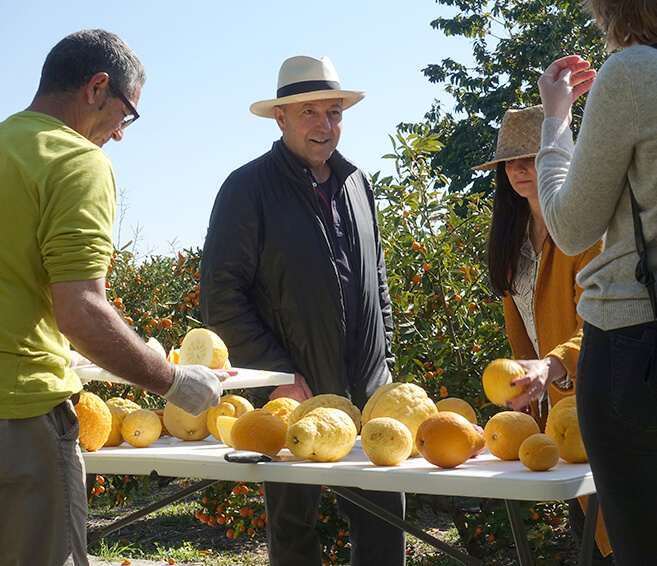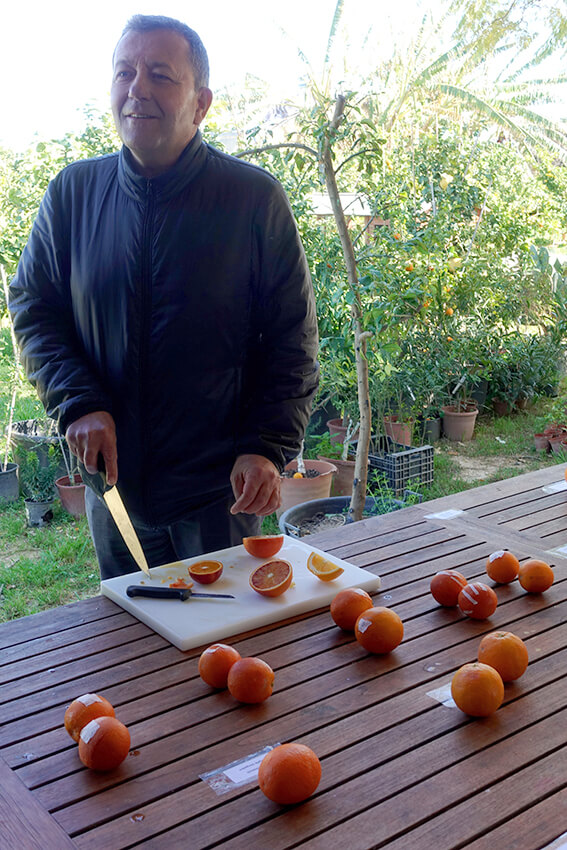Born in Tel Aviv in the sixties, Erez Komarovsky is considered one of the true pioneers of artisan bread-making in Israel. The celebrated chef and baker takes inspiration from his time spent in France and California, but above all draws on the rich melting pot of flavours and ingredients in his native land, and on the nature around him.
Vicente Todolí: Art and Citrus – Re-imagining Citrus Growing in Valencia
By Phoebe Hunt
The Spanish region of Valencia is one of the best known areas for citrus in the entire world. Oranges, lemons, grapefruits and limes are exported by the tonne from this fertile corner of the Mediterranean, bringing a taste of Spanish sunshine to our supermarkets. But this is the exact problem: beyond this handful of intensively farmed monocultures, the land is being drained of life. Many hundreds of rare citrus varieties are at risk of being lost forever, and the focus on mass production is wreaking havoc on the landscape.
This is where Vicente Todolí comes in. After decades working in the arts (the pinnacle of which was seven years as director of Tate Modern. He is currently artistic director at Pirelli Hangar Bicocca in Milan) he had a dramatic shift, and decided to come home to Spain and focus his energies on building a botanical orchard. Todolí Citrus Foundation is a lush citrus paradise in Palmera, Valencia, with more than 400 varieties of citrus trees across some 40,000 square meters. A passion project if ever there was one, Todolí’s decision may not have been as left-field as it seems – the deep connections between art and citrus run back to the Medici family in 16th century Italy, and he sees a lot of similarities between curating a museum and curating his citrus collection.

So, where did the inspiration come from to create this garden?
There are two aims, I suppose. Firstly I should mention that I’m the 5th generation of citrus specialists, so I grew up surrounded by citrus. At one point my father saw there was an opportunity to buy the orchard of my neighbour and start a small variety collection, with maybe 25 varieties. That was probably in the mid 90’s. At the time I was founding director of Serralves museum in Portugal, so the orange smallholding was just a small side passion, and my father took control of it. But he was happy I showed an interest in agriculture. He said “welcome back to the family.”
OK, this is the place where I can join my two interests, art and agriculture, and I can create a ‘museum’ which changes every day, as the seasons pass. There will be no need to change the collection, it refreshes itself. So this will be my museum of citrus!
My father died in 2003 just before I moved to London to run Tate Modern, so no one took care of the citrus garden. My brother (who had taken over the family business) asked one of his workers to cut the grass but the weeds were so high he ended up damaging many of the trees, which broke my heart. Then in around 2009 I did a book with the artist Richard Hamilton about Ferran Adria called Food for Thought. Thought for Food. As part of it, I went to the South of France and met a man with hundreds of citrus varieties in pots – the weather is much cooler there of course, so in winter he’d take them inside to a greenhouse. I asked Ferran “how is it possible that this guy is making such an incredible effort in an area that isn’t known for citrus, but in my area, Valencia, no one is doing it?” He replied: “Why don’t you do it yourself? And then something clicked.
So could you explain to us what your botanical orchard is?
Well, the Todolí Citrus Foundation is a space to grow all these varieties of citrus, but I’ve curated it like a museum as I say. I call it my botanical orchard, and it involves all the senses. That is the reason why the Arabs in Spain thought the closest place to paradise was a citrus garden surrounded by a wall. Especially in April and May, you see flowers, baby citrus and also ripe citrus. It’s like seeing life from generation to generation. Dai Dai in Japanese culture – or continuity.
The plan originally was to start with about 6000 meters, so maybe 50 varieties. But then I discovered they were planning to do a massive urbanisation project on the land nearby. So I went to the mayor and pitched my idea to stop this, to build the garden. Some travellers in 18th century described as the most fertile. It’s in an area which in the 19th century was the most fertile in Europe, and I wanted to protect it from being murdered. I don’t have kids, so it’s an homage to my family and sort of my legacy, and the trees will be my offspring. I kept buying buying buying, and finally the mayor embraced the project and it was recognised with Environmental Defence Interest.
And as someone who has built their whole career in curating art, can you tell us about the connections between these two worlds?
Once I started doing research, I found a nursery near Pistoia in Tuscany which was somehow connected to the Medici’s citrus collection. This is when I learned about the connection between art and citrus, as they collected both, and the more research I did the more points in common I found with art. I had already left Tate Modern, so I thought “OK, this is the place where I can join my two interests, art and agriculture, and I can create a ‘museum’ which changes every day, as the seasons pass. There will be no need to change the collection, it refreshes itself. So this will be my museum of citrus!”
Culinary creations are also part of my mission to protect diminished farmland. The old argument is “farmland is being abandoned because it’s not profitable.” It’s a big selling point for urbanisation, so if you can show that on a small plot you can make a successful business, you don’t need urban predators.
There’s an important reason why the Medici researched citrus fruit so intensely. As early as the 14th century in Florence, one of the main neo-platonists published a kind of research on ‘art and antiquity’ in Ancient Rome. This explained that art was very general, and it came under the umbrella of “the Opera” – it could be painting or music, but also gardening, or agriculture – they all had the same value. In order to be called opera it had to have a legacy, be bigger than life.
And how is the garden connected to the world of gastronomy?
Well, I also had the idea to turn the toolshed of my father into a gastronomic research center, so chefs can come there and experiment with citrus. Culinary creations are also part of my mission to protect diminished farmland. The old argument is “farmland is being abandoned because it’s not profitable.” It’s a big selling point for urbanisation, so if you can show that on a small plot you can make a successful business, you don’t need urban predators.
We’ve offered tasting tours for all sorts of amazing chefs, Michel Troisgros, Ferran Adria of course, Quique Dacosta who has a 3 Michelin star restaurant nearby (Denia), MªJosé Sanromán, 1 star Michelin (Alicante), and Ricard Camarena from Valencia who has 2 Michelin Stars. We are also sending rare citrus to Albert Raurich from Dos Palillos (Barcelona), and Andoni Aduriz from Mugaritz in Spain to cook several dishes with them. Jensen’s spirits from London had been also doing experiments with some different varieties, and most recently, Fernando Sáenz in Logroño, an avant garde ice cream maker who has developed new icecreams with our citrus. Also Mara dei Boschi in Torino. We want other people to use these less common fruits in other cooks to use their recipes to foster biodiversity.

Do you seek only to preserve rare and endangered species of citrus and to further research, or do you want these varieties to become widely available, for example in supermarkets?
Yes, I think eventually fruit which was once quite niche can enter into mainstream markets. For example when kumquat started being a thing 20 years ago no one knew it, now you can find them in the supermarket. Blood oranges are the same, they are usually consumed only in Italy, but now scientists have discovered that this color (anthocyanins and lycopenes) means they are rich in antioxidants, and they’re becoming popular. Aussie finger lime, also bergamot. If some big chef uses them, they become more popular – or at least in some specialist sections of the supermarket. This would mean more options for citrus growers and wood health fight against farmland abandonment.
And what is the importance of biodiversity when it comes to citrus?
Well different species are also key for research. Most citrus is produced through grafting, so you have to have real trees, not just seeds, so we can be a very useful resource. Also for medicine we are collaborating in some studies regarding citron and possible antitumor properties. Also we are collaborating with IVIA (Valencian Institute of Agricultural Research) in developing hybrid varieties which can fight HLP – using rare citrus to see if they can be used as a rootstock that is resistant. If you have them you can use them, you can do research and experiments and see what works.
